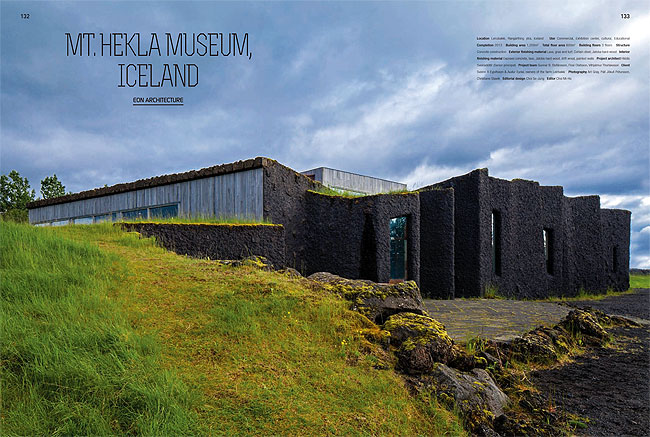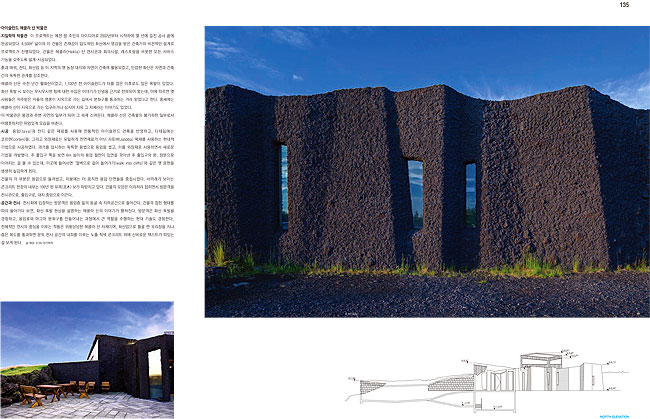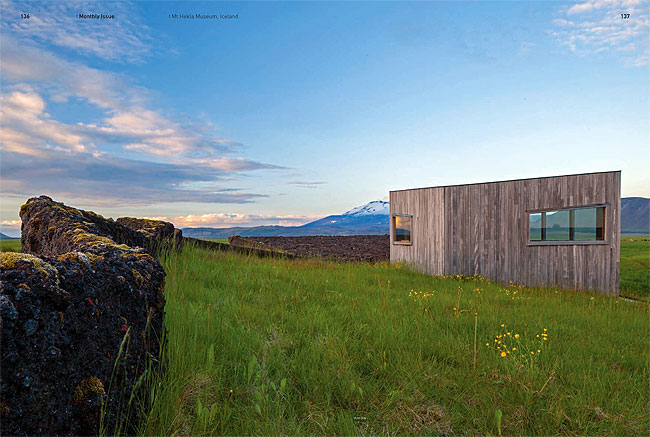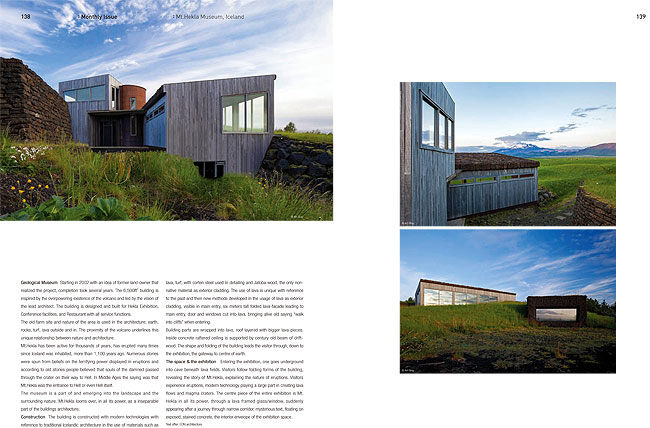Mt. Hekla Museum, Iceland
EON architecture




아이슬란드 헤클라 산 박물관 지질학적 박물관 이 프로젝트는 예전 땅 주인의 아이디어로 2002년부터 시작하여 몇 년에 걸친 공사 끝에 완공되었다. 6,500ft2 넓이의 이 건물은 존재감이 압도적인 화산에서 영감을 받은 건축가의 비전적인 설계로 프로젝트가 진행되었다. 건물은 헤클라(Hekla) 산 전시관과 회의시설, 레스토랑을 비롯한 모든 서비스 기능을 갖추도록 설계,시공되었다. 흙과 바위, 잔디, 화산암 등 이 지역의 옛 농장 대지와 자연이 건축에 활용되었고, 인접한 화산은 자연과 건축 간의 독특한 관계를 강조한다.
헤클라 산은 수천 년간 활화산이었고, 1,100년 전 아이슬란드가 터를 잡은 이후로도 많은 폭발이 있었다. 화산 폭발 시 보이는 무시무시한 힘에 대한 수많은 이야기가 신념을 근거로 전파되어 왔는데, 이에 따르면 옛 사람들은 저주받은 자들의 영혼이 지옥으로 가는 길에서 분화구를 통과하는 거라 믿었다고 한다. 중세에는 헤클라 산이 지옥으로 가는 입구라거나 심지어 지옥 그 자체라는 이야기도 있었다. 이 박물관은 풍경과 주변 자연의 일부가 되어 그 속에 스며든다. 헤클라 산은 건축물의 불가피한 일부로서 어렴풋하지만 위엄있게 모습을 비춘다.
시공 용암(lava)과 잔디 같은 재료를 사용해 전통적인 아이슬란드 건축을 반영하고, 디테일에는 코르텐(corten)을, 그리고 외장재로는 유일하게 천연재료가 아닌 자토바(Jatoba) 목재를 사용하는 현대적 기법으로 시공하였다. 과거를 암시하는 독특한 용법으로 용암을 썼고, 이를 외장재로 사용하면서 새로운 기법을 개발했다. 주 출입구 쪽을 보면 6m 높이의 용암 절판이 입면을 깎아낸 주 출입구와 문, 창문으로 이어지는 걸 볼 수 있는데, 이곳에 들어서면‘ 절벽으로 걸어 들어가기(walk into cliffs)’와 같은 옛 표현을 생생히 실감하게 된다.
건물의 각 부분은 용암으로 둘러쌌고, 지붕에는 더 큼직한 용암 단편들을 중첩시켰다. 서까래가 보이는 콘크리트 천장의 내부는 100년 된 유목(流木) 보가 떠받치고 있다. 건물의 모양은 이리저리 접히면서 방문객을 전시관으로, 출입구로, 대지 중앙으로 이끈다. 공간과 전시 전시회에 입장하는 방문객은 용암층 밑의 동굴 속 지하공간으로 들어간다. 건물의 접힌 형태를 따라 들어가다 보면, 화산 폭발 현상을 설명하는 헤클라 산의 이야기가 펼쳐진다. 방문객은 화산 폭발을 경험하고, 용암류와 마그마 분화구를 만들어내는 과정에서 큰 역할을 수행하는 현대 기술도 경험한다.
전체적인 전시의 중심을 이루는 작품은 위풍당당한 헤클라 산 자체이며, 화산암으로 틀을 짠 유리창을 지나 좁은 복도를 통과하면 문득 전시 공간의 내피를 이루는 노출 착색 콘크리트 위에 신비로운 텍스트가 떠있는 걸 보게 된다.
글 제공: EON 아키텍처
Geological Museum Starting in 2002 with an idea of former land-owner that realized the project, completion took several years. The 6,500ft2 building is inspired by the overpowering existence of the volcano and led by the vision of the lead architect. The building is designed and built for Hekla Exhibition, Conference facilities, and Restaurant with all service functions. The old farm site and nature of the area is used in the architecture; earth, rocks, turf, lava outside and in. The proximity of the volcano underlines this unique relationship between nature and architecture.
Mt.Hekla has been active for thousands of years, has erupted many times since Iceland was inhabited, more than 1,100 years ago. Numerous stories were spun from beliefs on the terrifying power displayed in eruptions and according to old stories people believed that souls of the damned passed through the crater on their way to Hell. In Middle Ages the saying was that Mt.Hekla was the entrance to Hell or even Hell itself. The museum is a part of and emerging into the landscape and the surrounding nature. Mt.Hekla looms over, in all its power, as a inseparable part of the buildings architecture.
Construction The building is constructed with modern technologies with reference to traditional Icelandic architecture in the use of materials such as lava, turf, with corten steel used in detailing and Jatoba wood, the only nonnative material as exterior cladding. The use of lava is unique with reference to the past and then new methods developed in the usage of lava as exterior cladding, visible in main entry, six meters tall folded lava-facade leading to main entry, door and windows cut into lava, bringing alive old saying “walk into cliffs” when entering. Building parts are wrapped into lava, roof layered with bigger lava-pieces. Inside concrete raftered ceiling is supported by century old beam of driftwood. The shape and folding of the building leads the visitor through, down to the exhibition, the gateway to centre of earth.
The space & the exhibition Entering the exhibition, one goes underground into cave beneath lava fields. Visitors follow folding forms of the building, revealing the story of Mt.Hekla, explaining the nature of eruptions. Visitors experience eruptions, modern technology playing a large part in creating lava flows and magma craters. The centre piece of the entire exhibition is Mt. Hekla in all its power, through a lava framed glass/window, suddenly appearing after a journey through narrow corridor, mysterious text, floating on exposed, stained concrete, the interior envelope of the exhibition space.
Text offer: EON architecture
건축문화 2016년 11월호 [Monthly Issue]페이지 © 에이엔씨출판(주)